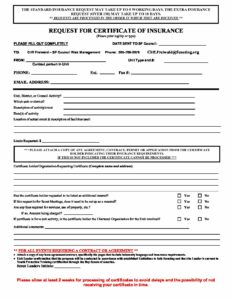Utilizing such standardized forms streamlines the verification process, reducing ambiguity and potential delays. This benefits both the requesting party, by ensuring they receive complete and accurate information, and the responding party, by providing a clear framework for supplying the necessary documentation. This efficiency minimizes errors and facilitates smoother transactions, contributing to a more reliable and trustworthy exchange of information.
This foundation in understanding the purpose and advantages of standardized requests for insurance verification allows for a deeper exploration of related topics, such as legal requirements, best practices for completion and processing, and the various contexts in which these forms play a crucial role.
Key Components of an Insurance Verification Request
Effective verification of insurance coverage relies on obtaining specific data points. Standardized requests facilitate this process by ensuring consistent and comprehensive information gathering.
1: Requestor Information: Clear identification of the party requesting proof of insurance, including the individual or organization’s name, address, and contact information, ensures efficient communication and proper routing of responses.
2: Insured Party Information: Accurate identification of the individual or entity whose insurance is being verified is essential. This typically includes the insured’s name, address, and potentially date of birth or business identification number.
3: Policy Information: This section specifies the type of insurance coverage being verified (e.g., auto, liability, homeowner’s) and may request specific policy numbers or other identifying information.
4: Effective and Expiration Dates: Requesting the policy’s effective and expiration dates confirms that the coverage is current and valid for the relevant period.
5: Coverage Limits: Understanding the policy’s coverage limits is crucial for assessing the adequacy of protection. This section requests specific liability limits or other relevant coverage amounts.
6: Additional Insured Status (if applicable): If the requesting party needs to be listed as an additional insured on the policy, this section provides space for indicating such a requirement.
7: Method of Response: Clear instructions on how to submit the proof of insurance, such as email, fax, or online portal, streamline the response process.
8: Deadline for Response: Specifying a reasonable timeframe for providing the requested documentation ensures timely verification.
Accurate and comprehensive data collection through these components ensures effective verification of insurance, facilitating informed decision-making and mitigating potential risks.
How to Create a Request for Evidence of Insurance
Creating a standardized request for evidence of insurance ensures clarity and efficiency in the verification process. The following steps outline the key components and considerations for developing such a template.
1: Define Purpose: Clearly articulate the reason for requesting proof of insurance. This provides context for the recipient and ensures the appropriate information is provided.
2: Requestor Identification: Include complete contact information for the requesting party, enabling efficient communication and accurate routing of responses. This should include the organization or individual’s name, address, phone number, and email address.
3: Insured Party Identification: Request specific details for identifying the insured party, such as legal name, address, and any relevant identification numbers (e.g., date of birth, business identification number). This ensures accurate verification of the correct policy.
4: Policy Information Requirements: Specify the required policy information, including the type of coverage (e.g., auto, liability, homeowner’s), policy number (if known), and any other relevant identifying details.
5: Specify Effective and Expiration Dates: Requesting the policy’s effective and expiration dates is crucial for validating current coverage.
6: Request Coverage Limits: Specify the required details regarding coverage limits, ensuring adequate protection for the situation. This may involve requesting specific liability limits or other relevant coverage amounts.
7: Address Additional Insured Status: If applicable, include a section for indicating whether the requesting party needs to be listed as an additional insured on the policy.
8: Outline Response Method and Deadline: Provide clear instructions for submitting proof of insurance (e.g., email, fax, online portal) and establish a reasonable deadline for submission. This facilitates timely processing and avoids delays.
A well-designed template, incorporating these elements, facilitates streamlined communication, reduces errors, and ensures efficient verification of insurance coverage. Consistent use of a standardized format contributes to improved risk management and informed decision-making.
Standardized forms for obtaining proof of insurance coverage promote efficiency and accuracy in verifying policy details. These templates ensure consistent data collection, covering essential information such as policyholder identification, coverage specifics, effective dates, and limits. Utilizing such structured requests streamlines communication between requesting and responding parties, minimizing ambiguity and potential delays.
Effective management of risk and liability often hinges on timely and accurate verification of insurance coverage. Implementing standardized processes, supported by well-designed templates, contributes significantly to mitigating potential issues and ensuring informed decision-making. This proactive approach fosters transparency and trust, ultimately promoting greater security and stability in various personal and professional contexts.

